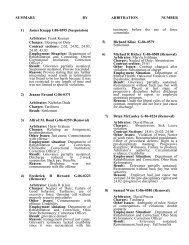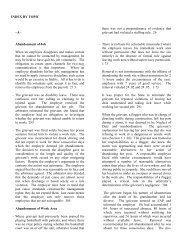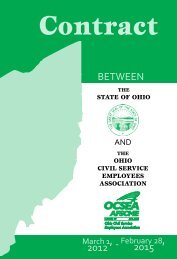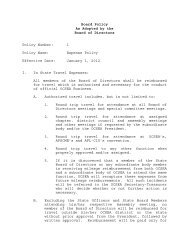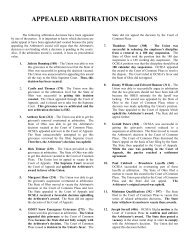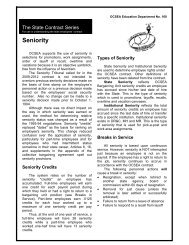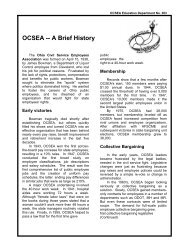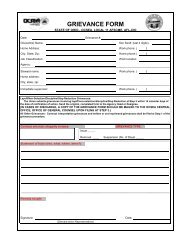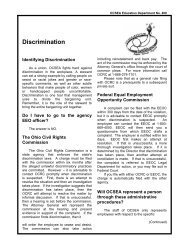by Contract Number (PDF) - OCSEA
by Contract Number (PDF) - OCSEA
by Contract Number (PDF) - OCSEA
You also want an ePaper? Increase the reach of your titles
YUMPU automatically turns print PDFs into web optimized ePapers that Google loves.
was determined. If she fails to obtain the position<br />
she occupied, the employer was ordered to place<br />
her back into the office which she had left so as<br />
to prevent any lost wages due to the transfers. If<br />
a person other than the transferred employee<br />
receives the position, that employee must be<br />
made whole for any lost wages and benefits. 399<br />
The grievant took a magnetic tape containing<br />
public information home, which was against<br />
agency rules. She intended to return the tape but<br />
it became lost, and she was charged with theft of<br />
state property. The tape was later recovered <strong>by</strong><br />
the Highway Patrol during an unrelated<br />
investigation. The grievant was transferred to<br />
another position without loss of pay or reduction<br />
in rank and suspended for 30 days. The arbitrator<br />
held that the employer failed to prove that the<br />
grievant intended to steal the tape (Hurst<br />
arbitration test applied) rather than borrow it.<br />
Taking the tape home without authorization was<br />
found to be a violation of the employers’ rules.<br />
The employer was found not to have applied<br />
double jeopardy to the grievant as only one<br />
disciplinary proceeding had been brought and the<br />
transfer was found not to be disciplinary in<br />
nature. The 30 day suspension was found not to<br />
be reasonably related to the offense, nor<br />
corrective and was reduced to a 1 day suspension<br />
with full back pay for the remaining 29 days.<br />
417<br />
ARTICLE 18 – LAYOFFS<br />
18.01 – Layoffs<br />
The arbitrator has the power to review whether<br />
the job abolishment and layoff was proper. 280<br />
The State has the burden to prove the layoff was<br />
proper. 280<br />
Lack of Work: Employer must show specific<br />
lack of work with comparisons of the individual<br />
duties of the employees before and after the job<br />
abolishments. 280<br />
See Esselburne v. Ohio Department of<br />
Agriculture,49 Ohio App. 3d 37, 41 (1988). 280<br />
Economy and Efficiency: Employer must show<br />
specific day to day function shat since they have<br />
been abolished have provided economy and<br />
efficiency. 280<br />
See Bispeck v. Trumbull County, 37 Ohio St. 3d<br />
26 (1988). The State may not erode the<br />
bargaining unit through the layoff procedure.<br />
Supervisors and other employees working out of<br />
class may not take over the laid off employee’s<br />
duties. 280<br />
Layoffs are to be made pursuant to the Ohio<br />
Revised Code, Section 124.321-327 and the<br />
Administrative Rules 123:1-41-01 through 22.<br />
Other sections of the Revised code and<br />
Administrative Rules are incorporated <strong>by</strong><br />
Section 43.02 of the Agreement. In the situation<br />
where state statutes and regulations confer<br />
benefits upon employees in areas where the<br />
Agreement is silent, the benefits shall continue.<br />
It was a benefit to employees prior to the<br />
institution of collective bargaining that the State<br />
Personnel Board of Review heard appeals from<br />
layoffs. Under Section 25.01 the grievance<br />
procedure is the “exclusive method” of resolving<br />
grievances. Employees covered <strong>by</strong> the<br />
Agreement no longer have access to the State<br />
Personnel board of Review in order to contest<br />
layoffs. The employees must grieve under the<br />
plain language of the Agreement. The parties<br />
altered the forum of review. The grievance<br />
procedure, including arbitration, now serves as<br />
the avenue of appeal. When appeals were taken<br />
to the Board of Review they were made pursuant<br />
to rules that are not specifically set out in the<br />
Agreement. One rule placed the burden upon the<br />
employer to demonstrate <strong>by</strong> “a preponderance of<br />
the evidence that a job abolishment was<br />
undertaken due to the lack of the continuing need<br />
for the position, a reorganization, for the efficient<br />
operation of the appointing authority, for reasons<br />
of economy or for a lack of work expected to last<br />
more than twelve months.” ORC 124-701(A)(1)<br />
This rule represents a benefit to employees and is<br />
continued under the language of Section 43.02 of<br />
the Agreement. The two major decisions in the<br />
area of layoffs are Bispeck and Esselburne.<br />
Bispeck emphasized that the burden is on the<br />
employer and Esselburne sets out the standard of<br />
proof the employer must show to carry its<br />
burden. The arbitrator decided that the employer<br />
must compare current work levels for the<br />
employees to a period when a lack of work did<br />
not exist. The State did not show that a lack of<br />
work existed in either of the layoffs. The State’s<br />
reference to the money that could be saved <strong>by</strong><br />
not paying the grievants does not prove that there<br />
existed a lack of funds. As Bispeck states,<br />
“Evidence of not having to pay the salaries on its



